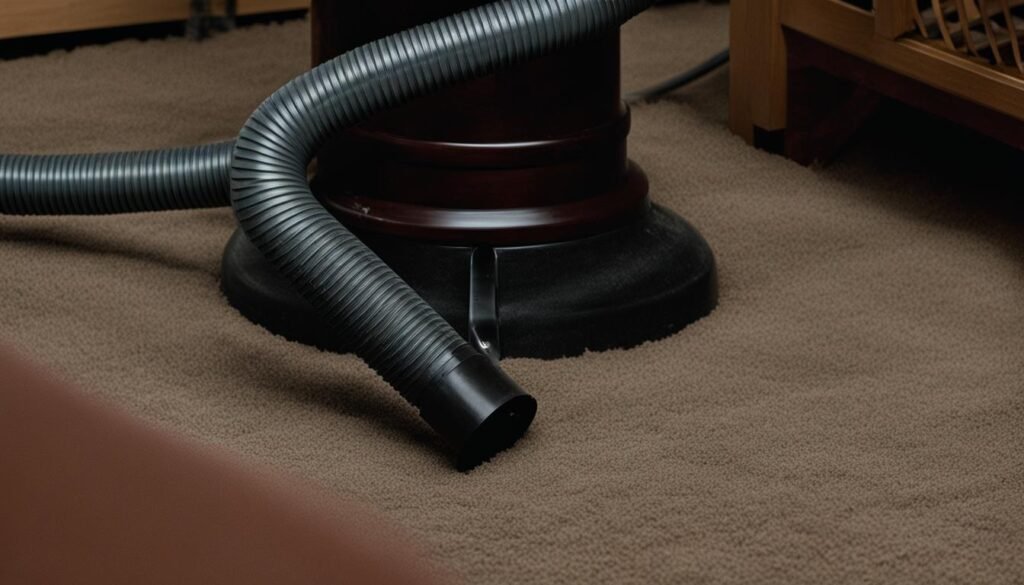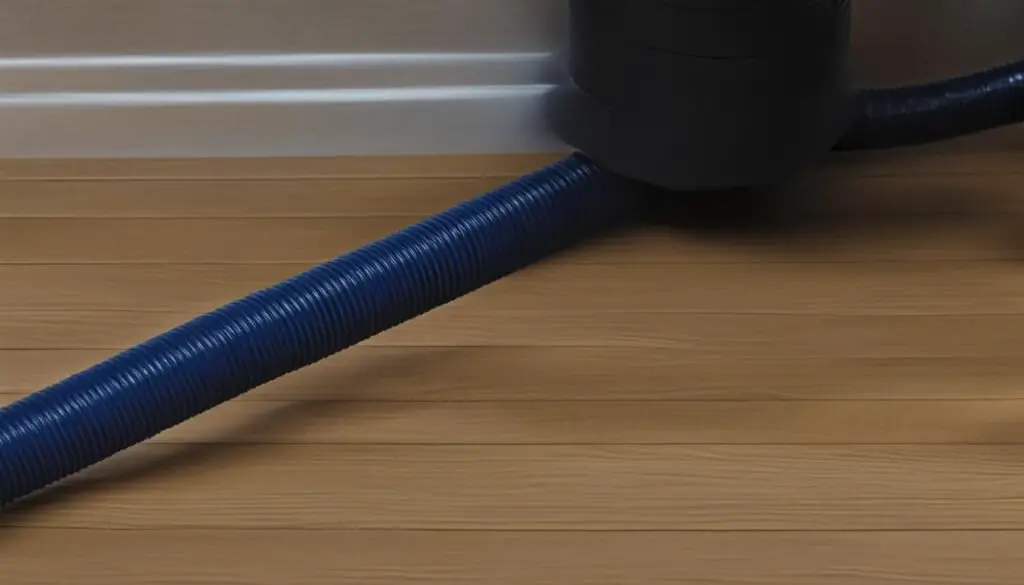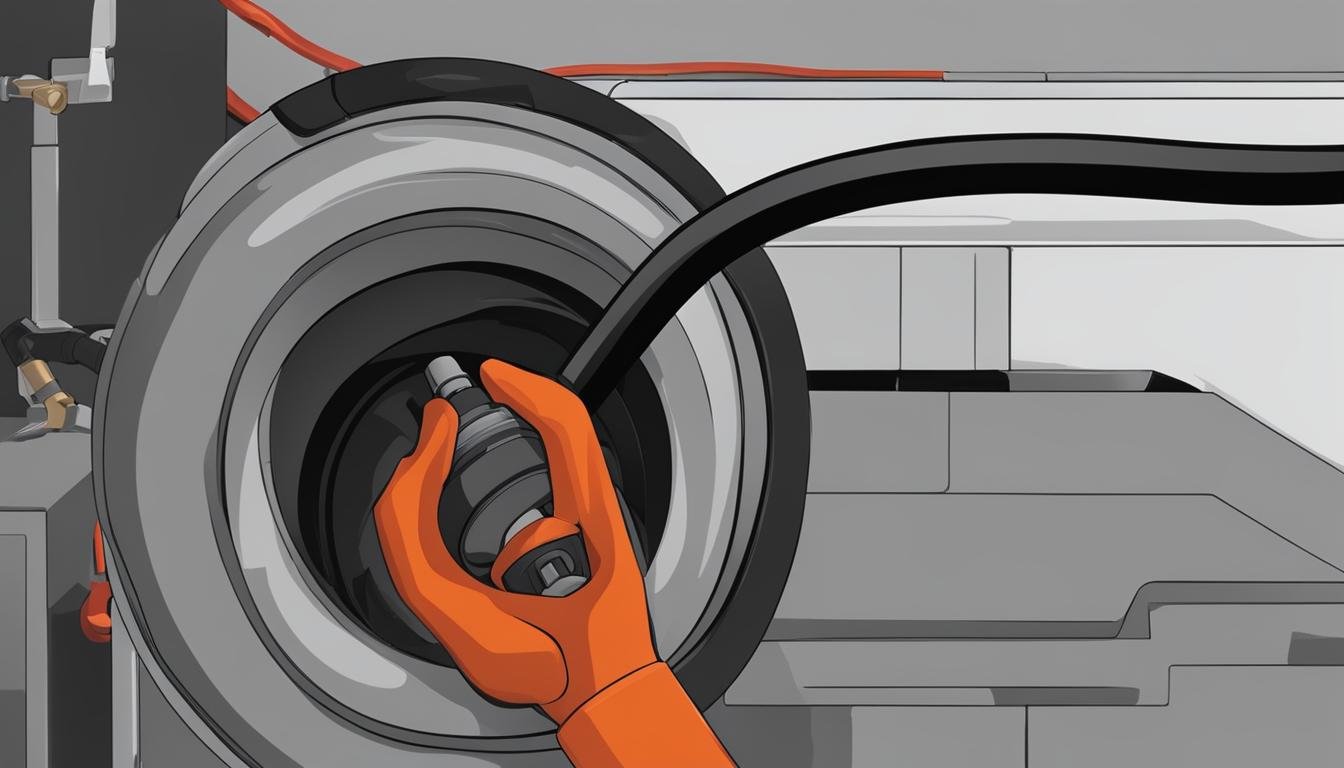Have you ever experienced the frustration of your vacuum hose working perfectly fine, but failing to pick up dirt from the bottom? It can be a puzzling problem, but fear not, as I’m here to help you troubleshoot the issue and get your vacuum back in tip-top shape.
One of the most common reasons for a loss of suction is blocked filters or a clogged vacuum cleaner hose. To start troubleshooting, let’s begin by unplugging the vacuum cleaner and checking the filters. Clean or replace them as necessary. Next, inspect the hose for any blockages. If there is suction from the hose but not from the main base, there may be a blockage in the base connecting tube or the beater bar may not be rotating properly.
In addition to these troubleshooting steps, it’s crucial to perform regular maintenance on your vacuum cleaner. For bagless vacuum cleaners, make sure to empty the dust canister regularly to prevent blockages. For bagged models, check that the bag is not full, as this can greatly affect the vacuum’s performance.
When it comes to loss of suction, there are various factors that can contribute to the issue. One common culprit is a clogged vacuum cleaner bag, which should be replaced frequently to maintain proper airflow. A blocked hose, obstructed by hair, dust bunnies, or other debris, can also impair suction. Additionally, a dirty or clogged filter can impede the overall performance of your vacuum cleaner. Lastly, it’s essential to inspect the machine for any cracked or damaged hoses, as air leakage can significantly impact suction power.
Key Takeaways:
- Blocked filters or a clogged hose are common causes of a vacuum hose not picking up dirt effectively from the bottom.
- Regular maintenance, such as cleaning or replacing filters and checking for blockages, is essential for optimal vacuum performance.
- Loss of suction can also be caused by a clogged vacuum cleaner bag, dirty filters, or cracked hoses.
- Inspect the vacuum cleaner’s hose, base connecting tube, and beater bar to ensure they are not obstructed or damaged.
- Proper usage and maintenance, following the manufacturer’s guidelines, can extend the lifespan of your vacuum cleaner.
Reasons for Loss of Suction
Loss of suction in a vacuum cleaner can be caused by several factors. One common reason is a clogged vacuum cleaner bag, which should be replaced regularly to maintain proper airflow. Another potential issue is a blocked hose, which can become obstructed with hair, dust bunnies, or other debris. Additionally, check the vacuum cleaner’s filter, as a clogged or dirty filter can impede suction. It’s also important to inspect the machine for any cracked or damaged hoses, as air escaping through a crack can affect performance.
To ensure optimal suction power, it’s crucial to address these potential issues. Regular maintenance and troubleshooting can help prevent loss of suction and keep your vacuum cleaner functioning effectively. Let’s take a closer look at each of these factors:
Clogged Vacuum Cleaner Bag
The vacuum cleaner bag plays a critical role in maintaining proper airflow. Over time, the bag can become filled with dirt, dust, and debris, restricting the flow of air through the machine. To prevent this, make sure to replace the bag regularly, especially when it reaches the manufacturer’s recommended capacity.
Blocked Hose
The vacuum cleaner hose is responsible for carrying suction from the base to the cleaning head. If the hose becomes blocked or obstructed, it can significantly reduce suction power. Check the hose for any hair, clogs, or debris. Gently remove any blockages to restore proper airflow.
Dirty or Clogged Filter
A clogged or dirty filter can hinder the suction performance of a vacuum cleaner. The filter captures fine particles and prevents them from entering the motor or escaping back into the air. Over time, the filter can become clogged with dust and debris. Clean or replace the filter according to the manufacturer’s instructions to maintain optimal suction power.
Cracked or Damaged Hoses
Inspect the vacuum cleaner hoses for cracks or damages. Even minor cracks can cause air leakage, resulting in a loss of suction. If you notice any cracks or damages, replace the hose to restore proper suction performance.
By addressing these potential issues, you can ensure that your vacuum cleaner maintains its suction power and effectively removes dirt and debris from your floors and surfaces.

| Loss of Suction Factors | Solution |
|---|---|
| Clogged vacuum cleaner bag | Regularly replace the bag. |
| Blocked hose | Check for obstructions and remove them. |
| Dirty or clogged filter | Clean or replace the filter. |
| Cracked or damaged hoses | Replace the hoses if necessary. |
Other Vacuum Cleaner Issues
In addition to loss of suction, vacuum cleaners can encounter various other problems that affect their performance and functionality. It’s essential to be aware of these issues to ensure your vacuum cleaner operates smoothly and efficiently.
Broken or Malfunctioning Belt
One common issue that can disrupt a vacuum cleaner’s operation is a broken or malfunctioning belt. The belt plays a crucial role in driving the agitator brush, which helps pick up debris from carpets and floors. If the belt becomes worn, loose, or broken, the brush may not rotate properly, leading to ineffective cleaning results.
Regularly inspect the belt for signs of wear and tear, and replace it if necessary. This simple maintenance task can significantly improve your vacuum cleaner’s performance and ensure optimal cleaning results.
Tangled Agitator Brush
The agitator brush in a vacuum cleaner can become tangled with hair, string, or other debris over time. When the brush gets entangled, it can obstruct its rotation, rendering it less effective in picking up dirt and debris.
To prevent this issue, it’s important to regularly clean the agitator brush. Remove any hair, threads, or other debris that may have accumulated on the brush. This simple maintenance step helps keep the brush clean, allowing it to spin freely and ensure efficient cleaning.
Vacuum Cleaner Motor Damage
Vacuum cleaner motors are susceptible to damage, particularly if exposed to moisture. It’s important to avoid using a vacuum cleaner not designed for wet cleaning on wet surfaces or liquids, as this can lead to motor damage and possibly render the machine inoperable.
Proper maintenance, including regular cleaning of filters to prevent clogs, can help maintain optimal airflow and reduce stress on the vacuum cleaner motor. By taking these preventive measures, you can prolong the lifespan of your vacuum cleaner and avoid costly repairs or replacements.
Vacuum Cleaner Maintenance
Maintaining your vacuum cleaner is crucial to ensure its longevity and optimal performance. Regular maintenance tasks, such as cleaning filters, checking belts, and inspecting hoses for cracks or blockages, can go a long way in preventing common issues and maximizing suction power.
Here are some essential maintenance tips for your vacuum cleaner:
- Clean or replace filters regularly to maintain proper airflow.
- Inspect and replace belts if they show signs of damage or wear.
- Check hoses for cracks, blockages, or other damage.
- Remove any hair, debris, or obstructions from the agitator brush regularly.
By following these maintenance practices, you can keep your vacuum cleaner in excellent condition and ensure it continues to perform effectively for years to come.

| Issue | Symptoms | Possible Solutions |
|---|---|---|
| Broken Belt | Agitator brush not rotating properly | Replace the belt |
| Tangled Agitator Brush | Poor suction or ineffective cleaning | Clean the brush and remove any tangles |
| Vacuum Cleaner Motor Damage | Lack of power or complete failure | Avoid using the vacuum cleaner on wet surfaces; consult a professional for repairs |
| General Maintenance | Reduced suction, poor performance | Clean or replace filters; check belts, hoses, and brushes regularly |
Conclusion
In conclusion, troubleshooting a vacuum hose that works but does not reach the bottom or pick up dirt effectively requires addressing common vacuum cleaner issues. The loss of suction can be attributed to blocked filters, a clogged hose, or other issues such as cracked hoses or damaged belts. Effective maintenance practices are pivotal in resolving these problems.
Regularly cleaning or replacing filters is imperative to maintain optimal airflow. Additionally, checking for blockages in the hose and ensuring the agitator brush is free from tangled debris play a pivotal role in restoring suction. Remember to consult the vacuum cleaner’s manual for specific instructions and reach out to the manufacturer for further assistance if necessary.
By adopting a proactive approach to troubleshooting and properly maintaining your vacuum cleaner, you can ensure its optimal performance and longevity. Take the necessary steps to address any issues promptly, and your vacuum cleaner will continue to be a reliable tool for keeping your home clean and fresh.
FAQ
Why is my vacuum hose working but not reaching the bottom?
If your vacuum hose is not reaching the bottom effectively, there may be a blockage in the base connecting tube or the beater bar may not be rotating. Check for any obstructions and ensure the beater bar is functioning properly.
What should I do if my vacuum hose is not picking up dirt effectively?
If your vacuum hose is not picking up dirt effectively, there could be a clog in the hose. Check for blockages such as hair, dust bunnies, or other debris that may be obstructing the flow of air. Clear any obstructions to improve suction.
How can I troubleshoot my vacuum hose?
To troubleshoot your vacuum hose, start by unplugging the vacuum cleaner and removing all filters to clean or replace them as necessary. Check the hose for any blockages and clear them if present. If the hose has suction but the main base does not, check for blockages in the base connecting tube and ensure the beater bar is rotating properly.
Why is my vacuum hose not suctioning properly?
If your vacuum hose is not suctioning properly, there may be a clog in the hose, a dirty or clogged filter, or a cracked or damaged hose. Check for and clear any blockages, clean or replace filters, and inspect the hose for any cracks or damages that may be affecting suction.
How do I maintain my vacuum cleaner?
Regular maintenance of your vacuum cleaner is important to ensure optimal performance. Clean or replace filters regularly, empty the dust canister for bagless models, and check that the bag is not full for bagged models. Clean the agitator brush to prevent tangling and check and replace belts as needed. Avoid using a vacuum cleaner not designed for wet cleaning to prevent damage to the motor.





Leave a Reply